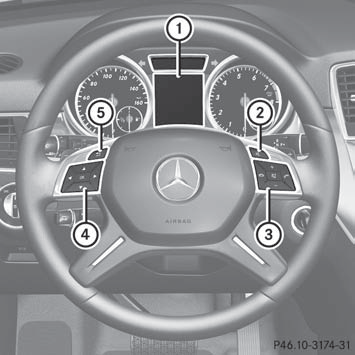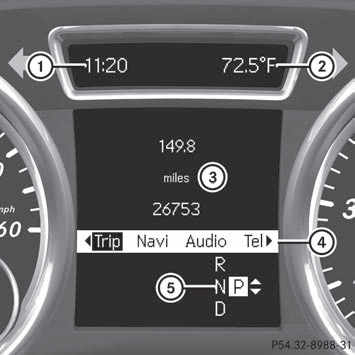Displays and operation
Coolant temperature display
 WARNING
WARNING
Driving when your engine is overheated can
cause some fluids which may have leaked into
the engine compartment to catch fire. You
could be seriously burned.
Steam from an overheated engine can cause serious burns which can occur just by opening the engine hood. Stay away from the engine if you see or hear steam coming from it.
Stop the vehicle in a safe location away from other traffic. Turn off the engine, get out of the vehicle and do not stand near the vehicle until the engine has cooled down.
The coolant temperature gauge is in the instrument cluster on the right-hand side.
Under normal operating conditions and with the specified coolant level, the coolant temperature may rise to 248 °F (120 °C).

If the coolant temperature is too high a
display message is shown.
If the coolant temperature rises above 248 °F(120 °C), do not drive any further as this could damage the engine.
Tachometer
The red band in the tachometer indicates the engine's overrevving range.

Do not drive in the overrevving range, as
this could damage the engine.
The fuel supply is interrupted to protect the engine when the red band is reached.
Outside temperature display
The outside temperature display is in the multifunction display.
 WARNING
WARNING
The outside temperature indicator is not
designed to serve as an ice-warning device
and is therefore unsuitable for that purpose.
Indicated temperatures just above the freezing point do not guarantee that the road surface is free of ice. The road may still be icy, especially in wooded areas or on bridges.
Changes in the outside temperature are displayed after a short delay.
Speedometer with segments
The segments in the speedometer indicate which speed range is available.
Cruise control (Y page 167) activated:
The segments light up from the stored speed to the maximum speed.
DISTRONIC PLUS (Y page 169) activated:
One or two segments in the set speed range light up.
DISTRONIC PLUS detects a vehicle in front:
The segments between the speed of the vehicle in front and the stored speed light up.
Operating the on-board computer
Overview
The on-board computer is activated as soon as you turn the SmartKey to position 1 in the ignition lock.
You can control the multifunction display and the settings in the on-board computer using the buttons on the multifunction steering wheel.

1 Multifunction display
2 To switch on the Voice Control System; see the separate operating
instructions
3 Right control panel
4 Left control panel
5 Back button
Left control panel
 |
- Calls up the menu and menu bar |
 |
Press briefly: - Scrolls through lists - Selects a submenu or function - In the Audio menu: selects a stored station, an audio track or a video scene - In the Tel (telephone) menu: switches to the phone book and selects a name or telephone number |
 |
Press and hold: - In the Audio menu: selects the previous/next station or selects an audio track or a video scene using rapid scrolling - In the Tel (telephone) menu: starts rapid scrolling through the phone book |
 |
- Confirms a selection/display message - In the Tel (telephone) menu: switches to the telephone book and starts dialing the selected number - In the Audio menu: stops the station search function at the desired station |
 |
- Adjusts the volume |
 |
- Mute |
Back button
 |
Press briefly: - Back - Switches off the Voice Control System - Hides display messages or calls up the last Trip menu function used - Exits the telephone book/redial memory |
 |
Press and hold: - Calls up the standard display in the Trip menu |
Multifunction display
Values and settings as well as display messages are shown in the multifunction display.

1 Time
2 Outside temperature or speed
3 Description field
4 Menu bar
5 Transmission position
For further information on displaying the transmission position, see (Y page 145).
The following messages may appear in the multifunction display:
 Active Parking Assist
Active Parking Assist
 Cruise control
Cruise control
 DSR
DSR
 Rear window wiper
Rear window wiper
 ATTENTION ASSIST
ATTENTION ASSIST
 Lane Keeping Assist or Active
Lane Keeping Assist or Active
Lane Keeping Assist
 HOLD function
HOLD function
 PRE-SAFE® Brake
PRE-SAFE® Brake
See also:
Pulling away
Automatic transmission
WARNING
If the engine speed is above the idling speed
and you engage transmission position D or
R, the vehicle could pull away suddenly. There
is a risk of an accident.
...
Manual drive program
Switching on the manual drive program
In manual drive program M, you can change
gear using the steering wheel paddle shifters
if the transmission is in position D. You can
see the currently select ...
